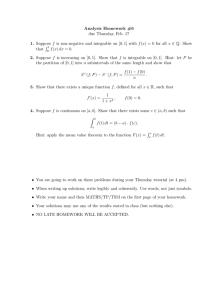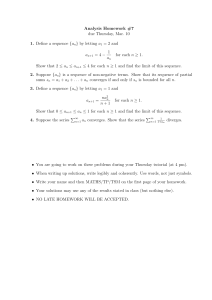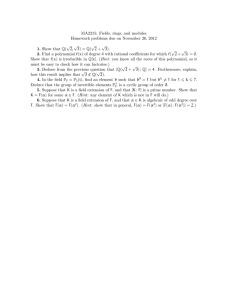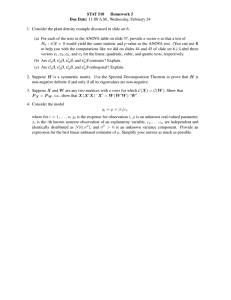On a Problem of Finbarr Holland
advertisement
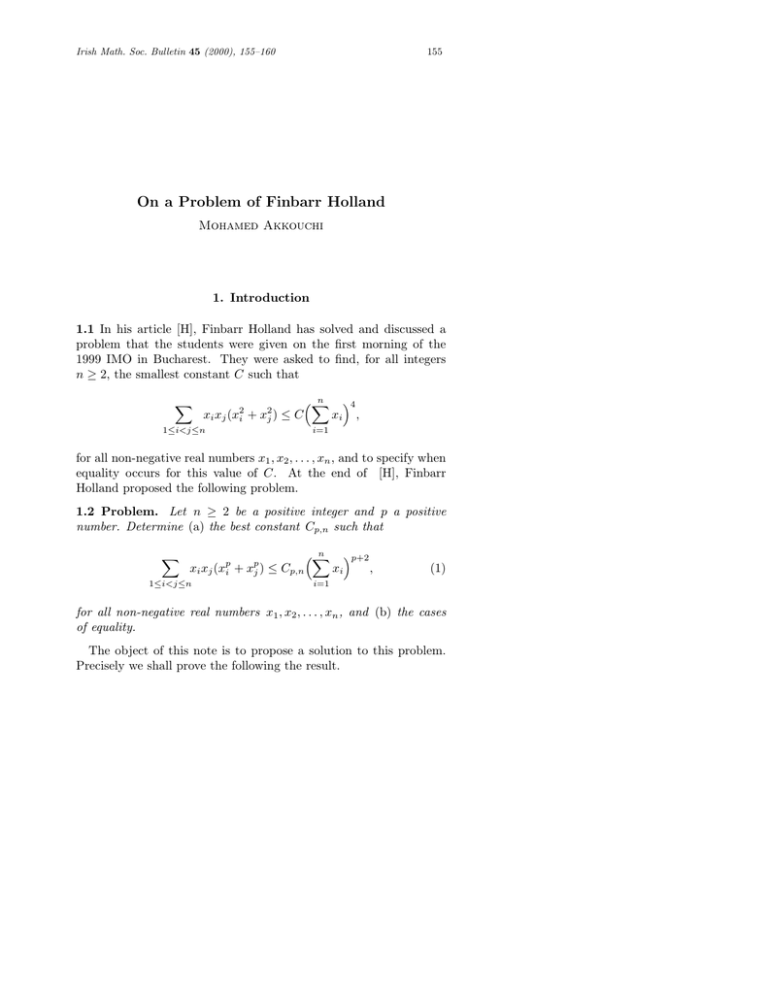
155
Irish Math. Soc. Bulletin 45 (2000), 155–160
On a Problem of Finbarr Holland
Mohamed Akkouchi
1. Introduction
1.1 In his article [H], Finbarr Holland has solved and discussed a
problem that the students were given on the first morning of the
1999 IMO in Bucharest. They were asked to find, for all integers
n ≥ 2, the smallest constant C such that
X
xi xj (x2i + x2j ) ≤ C
n
³X
xi
´4
,
i=1
1≤i<j≤n
for all non-negative real numbers x1 , x2 , . . . , xn , and to specify when
equality occurs for this value of C. At the end of [H], Finbarr
Holland proposed the following problem.
1.2 Problem. Let n ≥ 2 be a positive integer and p a positive
number. Determine (a) the best constant Cp,n such that
X
xi xj (xpi
1≤i<j≤n
+
xpj )
≤ Cp,n
n
³X
xi
´p+2
,
(1)
i=1
for all non-negative real numbers x1 , x2 , . . . , xn , and (b) the cases
of equality.
The object of this note is to propose a solution to this problem.
Precisely we shall prove the following the result.
156
Mohamed Akkouchi
1.3 Proposition. Let n ≥ 2 be a positive integer and p a positive
real number. Then the following assertions hold true.
(a) The best constant Cp,n satisfying (1) depends only on p and
1
satisfies 2p+1
≤ Cp,2 = Cp,n for all integers n ≥ 2.
(b) For all p > 0, we have Cp,2 = max{(1 − t)tp+1 + t(1 − t)p+1 :
0 ≤ t ≤ 12 }.
(c) If p ≥ 2, then Cp,2 =
(d) If 1 < p < 2, then
pp
.
(p+1)p+1
1
2p+1
≤ Cp,2 ≤
(e) If 0 < p ≤ 1, then Cp,2 =
1
2p+2
+
(p+1)p+1
.
(p+2)p+2
pp
.
(p+1)p+1
2. Proofs
We start by giving an equivalent formulation of Problem 1.2.
2.1 Problem. Let n ≥ 2 be a positive integer and p > 0. Determine
(a) the smallest constant Cp,n such that
n
X
xip+1 (1 − xi ) ≤ Cp,n ,
i=1
for all non-negative real numbers x1 , x2 , . . . , xn satisfying
1, and (b) the cases of equality.
Pn
i=1
xi =
This formulation holds since we have the following equality:
X
xi xj (xpi + xpj ) =
1≤i<j≤n
n
³X
i=1
xi
n
´ ³X
n
´ X
.
xp+1
−
xp+2
i
i
i=1
i=1
Pn
We let ∆n := {(x1 , x2 , . . . , xn ) ∈ [0, 1]n : i=1 xi = 1}. For every
p
real number t, we set FP
p (t) := (1−t)t . For all x = (x1 , x2 , . . . , xn ) ∈
n
n
n
R , we put Hp (x) := i=1 xi Fp (xi ). Another formulation of Problem 2.1 is then as follows.
2.2 Problem. Let n ≥ 2 be a positive integer and p > 0. Determine
(a) sup{Hpn (x) : x ∈ ∆n } = Cp,n , and (b) the set of points in ∆n
where this maximum is attained.
2.3. We start with the case p ≥ 1. Along the lines of the paper [H],
we distinguish four cases; Case (A), in which we suppose all of the xi
On a Problem of Finbarr Holland
157
are in the interval [0, 21 [; Case (B) in which we suppose that exactly
one of the xi belongs to ] 12 , 1]; Case (C) in which we suppose that
exactly one of the xi equals to 12 ; and Case (D) in which we suppose
that precisely two of the xi are equal to 12 . These cases exhaust all
possibilities.
Case (A). It is easy to see that the function x 7→ xp (1 − x) is strictly
increasing on the interval [0, 12 [, and that max{xp (1 − x) : 0 ≤ x <
1
1
2 } = 2p+1 . So, in this case, we have
n
X
xp+1
(1 − xi ) ≤ max xpi (1 − xi )
i
1≤i≤n
i=1
n
X
xi
i=1
= max xpi (1 − xi )
1≤i≤n
<
1
2p+1
.
Case (B). Suppose that xk belongs to ] 12 , 1]. We denote it by a and
relabel the remaining P
n − 1 variables as y1 , y2 , . . . , yn−1 . We have
n−1
the relation 1 − a = i=1 yi , from which we deduce that each yi
belongs to [0, 1 − a] ⊂ [0, 12 [. It follows that
yip (1 − yi ) ≤ a(1 − a)p , i = 1, 2, . . . , n − 1.
Hence
n
X
xp+1
(1 − xi ) = ap+1 (1 − a) +
i
n−1
X
yip+1 (1 − yi )
i=1
i=1
≤ ap+1 (1 − a) +
max yip (1 − yi )
1≤i≤n−1
≤ (1 − a)ap+1 + a(1 − a)p+1 .
n−1
X
yi
i=1
We conclude that in this case, we have
n
X
i=1
xp+1
(1 − xi ) ≤ max{(1 − t)tp+1 + t(1 − t)p+1 :
i
1
≤ t ≤ 1}.
2
Case (C). This is treated in a similar manner to Case (B), and we
obtain
n
X
1
xip+1 (1 − xi ) ≤ p+1 .
2
i=1
158
Mohamed Akkouchi
Case (D) is trivial, and it shows that we have Cp,n ≥
1
2p+1 .
The conclusion of this analysisP
so far is that, if x1 , x2 , . . . , xn are
n
non-negative numbers satisfying i=1 xi = 1, then
n
X
xip+1 (1 − xi ) ≤ max{(1 − t)tp+1 + t(1 − t)p+1 :
i=1
1
≤ t ≤ 1}.
2
It is clear that
Cp,2 = max{(1 − t)tp+1 + t(1 − t)p+1 :
1
≤ t ≤ 1},
2
and it is easy to see that Cp,2 at most is
( n
)
n
X p+1
X
xi (1 − xi ) : x1 , . . . , xn ∈ [0, 1],
Cp,n = max
xi = 1 .
i=1
i=1
Thus, we have proved part of (a). The assertion (b) is clear.
2.4. We suppose that p > 0. Let us introduce the function
hp (t) := Hp2 (t, 1 − t) = t(1 − t)[tp + (1 − t)p ]
∀t ∈ R.
p
Since the function Fp is concave on [0, ∞[ having Fp ( p+1
) as the
(only) maximal value, we obtain, for all t ∈ [0, 1],
hp (t) = tFp (t) + (1 − t)Fp (t)
≤ Fp (t2 + (1 − t)2 ) ≤ Fp (
Since hp ( 12 ) =
p > 0.
1
2p+1 ,
we deduce that
pp
p
)=
p+1 .
p+1
(p + 1)
1
2p+1
≤ Cp,2 ≤
pp
(p+1)p+1
for all
2.5. We suppose that p ∈ [2, ∞[. We shall
q prove that Cp,2 =
pp
p−1
1
1
:=
−
.
To
this
end,
we
consider
u
(1
2
p+1 ) and v := 2 (1 +
(p+1)p+1
q
p−1
p+1 ); these are the solutions (belonging to [0,1]) of the algebraic
p
. According to the convexity of the
equation t2 + (1 − t)2 = p+1
p−1
function t 7→ t
on [0, ∞[, we deduce that
p
hp (u) =
(uup−1 + vv p−1 )
2(p + 1)
p
pp
pp
≥
(u2 + v 2 )p−1 =
≥
.
2(p + 1)
2(p + 1)p
(p + 1)p+1
On a Problem of Finbarr Holland
159
p
p
According to 2.5, we conclude that Cp,2 = (p+1)
p+1 .. Thus we have
proved (c). The assertion (d) is easy to obtain, hence we omit it.
2.6. To complete the proof, we look at the case 0 < p ≤ 1. It
is clear that in this case, the function t 7→ tp−1 is decreasing and
p
1
], we have 1 − t ≥ p+1
and
convex on ]0, ∞[. For all t ∈]0, (p+1)
p
1
2
2
t + (1 − t) ≥ 2 ≥ p+1 , therefore
Cp,2 ≥ hp (t) = t(1 − t)(ttp−1 + (1 − t)(1 − t)p−1 )
≥ t(1 − t)(t2 + (1 − t)2 )p−1 ≥ t
We deduce then that Cp,2 ≥
all x ∈ ∆, we have
n
X
pp
(p+1)p+1 .
(1 − xi ) ≤ Fp (
xp+1
i
i=1
pp−1
.
(p + 1)p
For every integer n ≥ 2 and
n
X
p
p
)
xi = Fp (
).
p + 1 i=1
p+1
p
Thus, we find Cp,2 = Cp,n = Fp ( p+1
)=
Proposition 1.3.
pp
(p+1)p+1 .
So we have proved
3. Remarks
3.1. In the case where 1 < p < 2, we have only obtained upper and
lower estimates for the best constant Cp,n . We believe that (in this
case) the following equality holds
Cp,2 = Fp (
p
),
p+1
but we have no proof. We conclude this note by giving another
problem generalizing Problem 1.2.
3.2 Problem. Let n, k be positive integers such that k ≤ n and
p > 0. Determine (a) the smallest constant Cp,n,k such that
X
xi1 xi2 . . . xik (xip1 +xpi2 +. . .+xpik ) ≤ Cp,n,k
n
³X
1≤i1 <i2 <...<ik ≤n
for all non-negative real numbers x1 , x2 , . . . , xn satisfying
1, and (b) the cases of equality.
xi
´p+k
,
i=1
Pn
i=1
xi =
160
Mohamed Akkouchi
References
[H] Finbarr Holland, Three problems in one, Irish Mathematical
Society Bulletin 43 (1999), 73–78.
Mohamed Akkouchi,
Département de Mathématiques,
Faculté des Sciences-Semlalia,
Université Cadi Ayyad,
Avenue du prince My. Abdellah. B.P. 239,
Marrakech, Morocco
Received on 1 March 2000 and in revised form on 5 December 2000.
